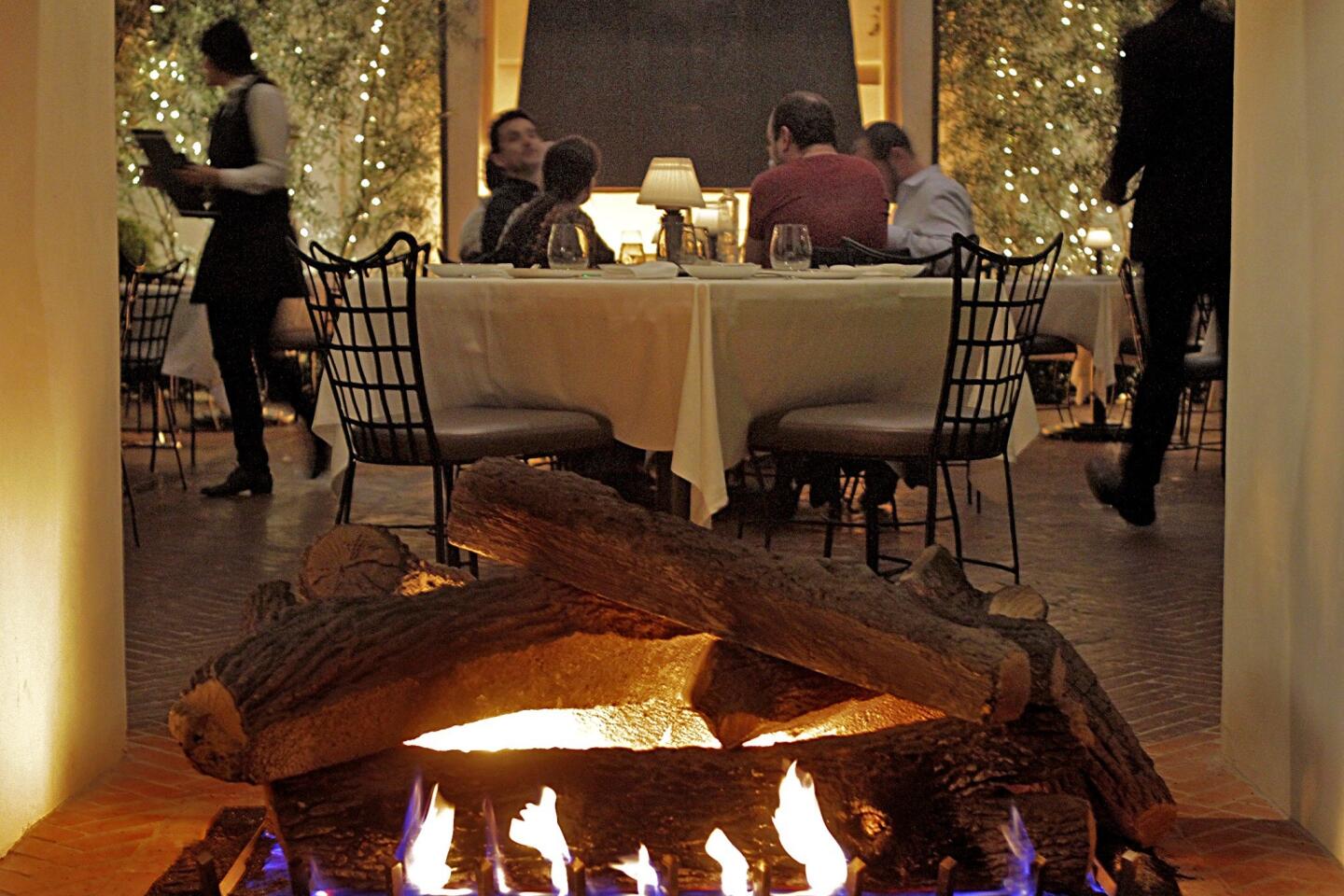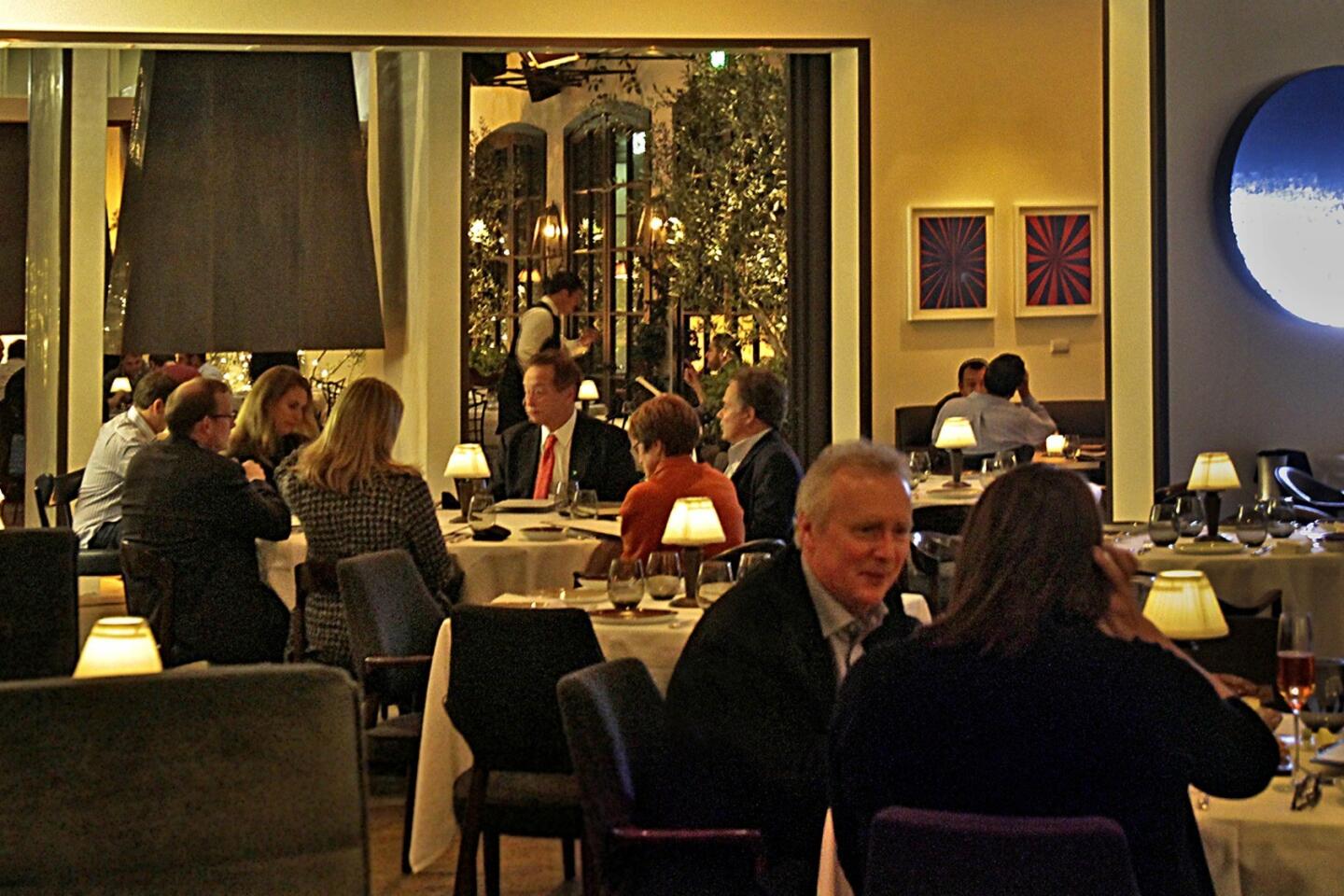Counter Intelligence: Spago makeover smooths aging star’s wrinkles
- Share via
The first responsibility of any great restaurant is to keep you in the bubble, the soft-serve cocoon of illusion where you forget the world exists for anything but your pleasure. And the newly redesigned Spago, from the moment you toss your keys to the valet to the moment you stagger back out again, gives good bubble.
The thick prime rib steak sings with the flavors of blood, age and char; the tagliatelle with white truffles perfumes half the observable universe when its glass dome is whisked away. Sommeliers beam at the brilliance of your wine selection as if it weren’t the sixth bottle of that Austrian Riesling they’d sold that evening. There is important art on the walls, including a photograph of a shattered cellphone the size of Pau Gasol, and a painting you could swear you saw at an Ed Ruscha retrospective, and while the music may tend toward the sort of ‘80s rock your meathead younger brother may have stashed on his iPod, at least you are not picking at your hearts of palm salad to the beat of hotel-lobby electronica.
Jonathan Gold quiz: Do you know your gingerbread?Waldo Fernandez, designer to the stars, chopped and channeled the dining room, enlarging the skylight, taking a death ray to the encrusted layers of kitsch, making the room modern, although not oppressively so. The formerly cramped tables near the open kitchen now seem like the most desirable in the house, and the patio, when it is covered on cold nights by the new, retractable roof, looks more like the great hall of a $10-million Aspen ski lodge than a Bel-Air garden party. The olive trees are still there, as is the Expressionist stage-set lighting, but the Hollywood fun that Barbara Lazaroff once brought to the restaurant has been bleached right out of the place. Spago is still lovely, perhaps lovelier, but it could as well be in New York or Las Vegas as L.A.
When Wolfgang Puck moved Spago from West Hollywood to Beverly Hills 15 years ago, his mission was clear. The original restaurant had been a funky, cheerful place, a big-city trattoria designed as a side project to Puck’s serious cooking at Ma Maison. It had the inadvertent effect of changing Los Angeles from a Le and La sort of town into the world capital of casually elegant dining. It turned out that the dudes with the platinum cards really did like hanging out on Spago’s wacky furniture better than they liked dressing up for salmon en croute.
As a young critic in the 1980s, I spent a long time worrying about the effect of Spagonomics. Restaurants here were effectively constrained from charging more for foie gras and truffles than Puck did for broccoli pasta and goat-cheese salad at the most popular restaurant in town, which effectively choked off haute cuisine in Los Angeles. And although Puck basically invented the modern idea of Asian fusion cooking at Chinois and the idea of the brewpub at Eureka, I also fretted about his considerable talents being wasted on glamorized snack food.
The 1997 move to Beverly Hills was supposed to scrub the casualness out of Spago, to cement its reputation as the serious restaurant it had become and to establish Puck’s personal cuisine — the Austrian flavors of his youth, expanded and elevated through amplified flavors, superior local produce and impeccable French technique. It kind of worked. Marrow dumplings and Kaiserschmarrn never quite took the place in local food culture once held by duck-sausage pizza and chocolate-raspberry terrine, but Spago affirmed its position as the flagship of a vast restaurant empire, and Puck, one of America’s first celebrity chefs, was still the most recognizable toque in the U.S.
But as the current century slouches into its teens, Puck stands at a crossroads. Swifty Lazar, Tony Curtis and Billy Wilder are gone, and the tastes of the young Hollywood generation tend toward bottle service and dirty Vegas weekends. Puck is an engaging guest on talk shows, but on television he has clearly been elbowed aside by a younger, less-accomplished crowd. It is hard even to imagine him as a contestant on “Top Chef Masters,” and while he could outcook Gordon Ramsay with both whisks tied behind his back, gratuitous cruelty isn’t his gig. Whatever is possible to do as a hot chef in this country he has done a dozen times over, with exclamation points.
Which leaves him basically with the challenge of making Spago relevant again, of reestablishing it as an international culinary destination; wrestling it into the modernist-leaning pantheon of Noma, Mugaritz, Le Chateaubriand and the French Laundry, that quirky landscape of restaurants where each dish is simultaneously what it appears to be and its opposite, where it is not enough to cook fish well; it must be imbued with meaning. It is hard enough to present fish/metafish in converted dairy barns that serve cocktails in jelly jars. At a place like Spago, with its size, reputation and devoted clientele, it would seem nearly impossible. Winners of Lifetime Achievement Awards don’t tend to start making Godard-scale films.
But as at the Celler de Can Roca, the modernist Catalan restaurant currently ranked second on the San Pellegrino list of the world’s best, you may be presented with a tiny gnarled tree a minute after you have settled yourself at the table. In Spain, the tree bears golden fruit — caramel-wrapped olives. From Spago’s tree, you pluck at acorn-shaped potato-lattice baskets filled with wild mushrooms. A bowl tricked out to resemble a tide pool may hold half a dozen empty shells and one cupping a perfect sautéed oyster sprinkled with caviar. What looks like a marrow bone is stuffed with a cold veal tartare flavored with chopped pickles and the usual garnishes — what looks like the marrow is a cap of smoked mascarpone cheese. In the manner of three-star San Sebastian chef Martín Berasategui, sautéed black sea bass is presented with its scales, standing at attention and fried crisp with boiling oil poured over its skin.
Puck, his new chef Tetsu Yahagi and his resident chefs Lee Hefter and Ari Rosenson have a handle on modernist cuisine. Yahagi especially brings a fresh take on Japanese cooking to the menu — there is both a persuasive sashimi of Japanese tai drizzled with ponzu, and sea urchin served in its shell with a bit of rice porridge and a splash of foamy sauce made from yuzu kosho, a pungent Japanese condiment made with green chile and yuzu zest.
The list of vegetable dishes, a roster of Brussels sprouts with miso and maple, pommes Lyonnaise made with Weiser Family Farm’s pee-wee potatoes and tangles of sautéed onions, and McGrath Family Farm broccolini with sun-dried tomatoes, sometimes includes roasted maitake, mushrooms valuable enough to have launched shooting wars in the Oregon woods. Yahagi’s take on chirashi, the famous dish of sashimi scattered over a bowl of sushi rice, is redone as a rustic wooden crate with uni, salmon roe, and (unfortunately, it’s severely over-fished) bluefin tuna arranged over a bit of rice; real wasabi and house pickled ginger among the accompaniments. The cold soba noodles with lobster or crab are umami-rich and delicious.
As always with Western restaurants preparing Asian food, the question arises: Even though Puck shops at the same Japanese fish wholesalers as chefs like Nobu Matsuhisa and Shunji Nakao and is prestigious enough to get the same quality of fish as the city’s best sushi bars, would you rather have your kaiseki dishes at n/naka or your sashimi at Urasawa? The match probably goes to the specialists, but it is a testament to the Spago team that one even wonders about the question.
But Spago is not a Japanese restaurant. Nor, really, is it a modernist restaurant. Modernist restaurants are built around their tasting menus. The new Spago has actually de-emphasized its tasting menu in favor of an Italian-style menu structure, with courses laid out as “One,” antipasti; and “Two,” pasta, including a saffrony risotto with bits of Maine shrimp. “Three” indicates main courses, like firm, fresh diver scallops with lemon and crisped prosciutto, Chinese-style roast duck with bao buns or rare grilled lamb chops with yogurt-stuffed falafel “macarons.” And “From the Garden” lists vegetables, or contorni, which are placed on the table on custom iron stands. The plates look rustic and Japanese but are made to Puck’s specifications by the venerable French porcelain manufacturer Bernardaud. And while the wild king salmon may be grilled over Japanese bincho charcoal, flavored with yuzu kosho and served with those maitake mushrooms, it is still essentially a French presentation, ideally enjoyed with a glass of Austrian wine. You are still at Spago. All is right with the world.
Wolfgang Puck shoots for legacy status and scores.
LOCATION
176 N. Canon Drive, Beverly Hills, (310) 385-0880, https://www.wolfgangpuck.com/restaurants/fine-dining/3635
HOURS
Lunch, noon to 2:15 p.m. Tuesdays to Thursdays and Saturdays, 11:30 a.m. to 2:15 p.m. Fridays. Dinner, 6-10 p.m. nightly.
PRICES
First courses, $12-$21; second courses, $14-$24 (more with truffles — a lot more); main courses, $34-$78.
DETAILS
Full bar. Credit cards accepted. Valet parking. Catering and private rooms.
More to Read
Eat your way across L.A.
Get our weekly Tasting Notes newsletter for reviews, news and more.
You may occasionally receive promotional content from the Los Angeles Times.






















